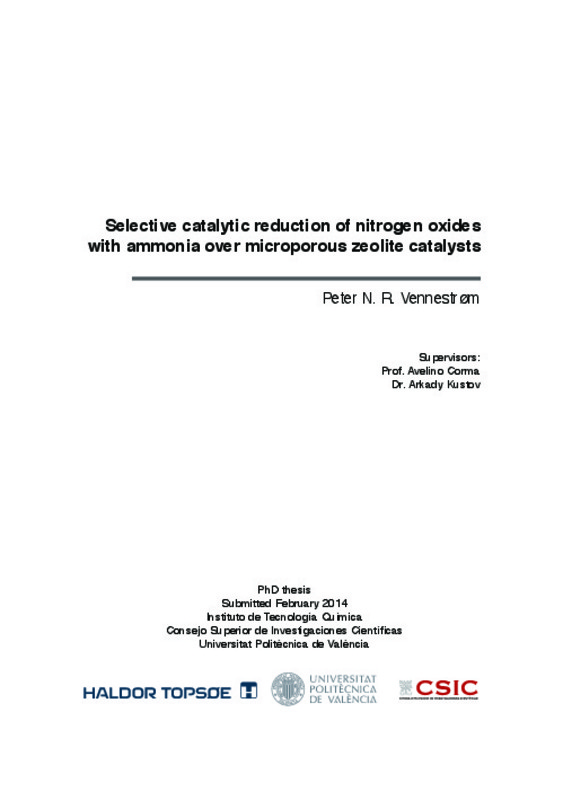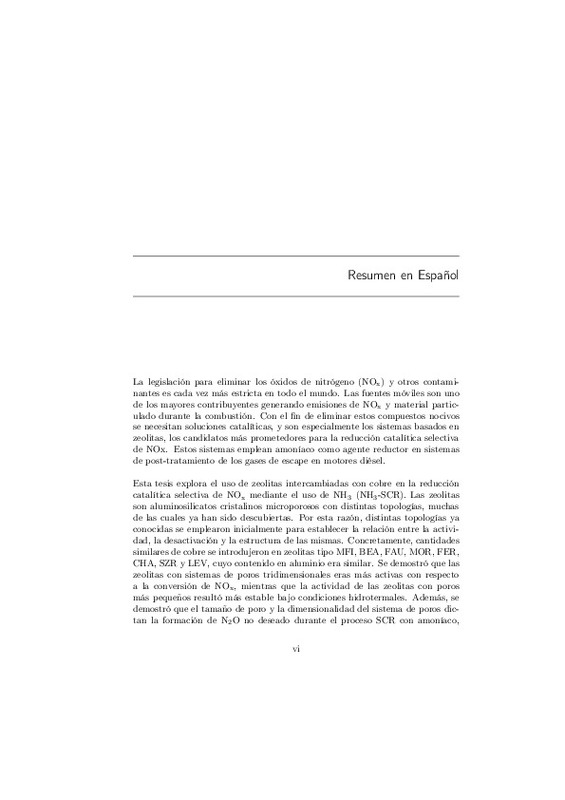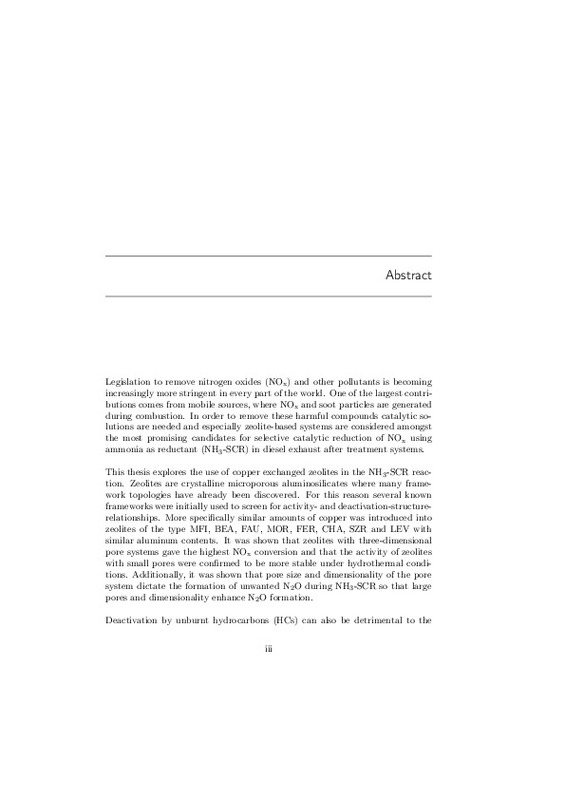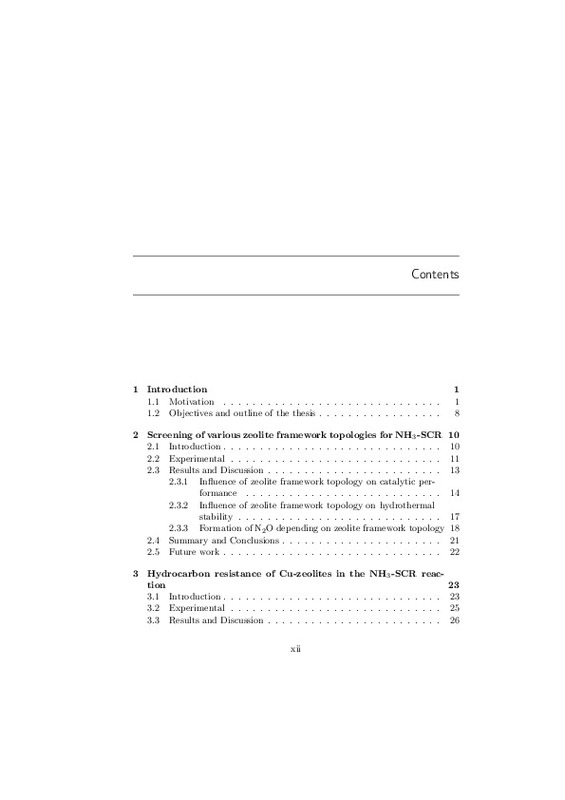- RiuNet repositorio UPV
- :
- Investigación
- :
- Tesis doctorales
- :
- Ver ítem
JavaScript is disabled for your browser. Some features of this site may not work without it.
Buscar en RiuNet
Listar
Mi cuenta
Estadísticas
Ayuda RiuNet
Admin. UPV
Selective catalytic reduction of nitrogen oxides with ammonia over microporous zeolite catalysts
Mostrar el registro sencillo del ítem
Ficheros en el ítem
| dc.contributor.advisor | Corma Canós, Avelino
|
es_ES |
| dc.contributor.advisor | Kustov, Arkady
|
es_ES |
| dc.contributor.author | VENNESTROM, PETER NICOLAI RAVNBORG
|
es_ES |
| dc.date.accessioned | 2014-10-14T06:53:36Z | |
| dc.date.available | 2014-10-14T06:53:36Z | |
| dc.date.created | 2014-09-25T10:00:55Z | es_ES |
| dc.date.issued | 2014-10-14T06:53:31Z | es_ES |
| dc.identifier.uri | http://hdl.handle.net/10251/43217 | |
| dc.description.abstract | With increasing legislative demands to remove nitrogen oxides (NOx) from automotive diesel exhaust, new catalyst systems are investigated and intensely studied in industry as well in academia. The most prevailing catalytic method of choice is the selective catalytic reduction (SCR) where non-toxic urea is used as a reductant for practical reasons. Usually urea is stored in a separate tank and once injected into the exhaust system it hydrolyses into the more aggressive reductant NH3 and CO2. 4 NH3 + 4 NO + O2 -> 4 N2 + 6 H2O (NH3-SCR reaction) In regions where vanadium is not banned cost effective V2O5/WO3/TiO2 NH3-SCR catalyst systems can be used. Vanadium based are well understood, but they do however not provide stability above ca. 550 °C for longer periods of time. In exhaust treatment systems where the temperature is either high or where high temperature excursions are experienced from e.g. regeneration of particulate filters, zeolite based catalysts are therefore today the most promising candidates as high-temperature stable and non-toxic catalysts for the NH3-SCR reaction. Among the most promising candidates are the Cu- and Fe-based zeolites. Usually Fe based zeolites show good performance in the temperature range 250-500 °C and reasonable stability, whereas Cu-based zeolites show good low-temperature activity in the 180-400 °C range. The presence of copper does however also lead to a lower stability of the catalyst material. Since the low-temperature activity is of paramount importance it is necessary to improve this behavior. Therefore the purpose of this project is to investigate: - The deactivation mechanism of copper based zeolites - The influence of the zeolite framework on stability and activity These investigations should mostly be carried out on model systems such as Cu-ZSM-5 and Cu-IM-5. Recently it was found that zeolite materials with the CHA-type structure show increased hydrothermal stability, most likely originating from the small 8-MR window openings in the structure. Part of the project should therefore also include investigations on this type and other similar structures, and therefore entail: - Synthesis, in-depth characterization and catalytic testing of Cu-SSZ-13 and Cu-SAPO-34 (both structures having the CHA-type framework) - Theoretical DFT calculations on relevant parameters found by the in-depth investigation of the afore-mentioned materials - Synthesis and testing of similar materials with 8-MR windows to elucidate the influence of the zeolite sub-structure i.e. if different ring sizes in the structure influences the catalytic performance Relevant characterization techniques include, besides conventional methods, in situ methods such as: high resolution (transmission) electron microscopy, infrared (and raman) spectroscopy together with X-ray absorption spectroscopy. These are all techniques that will complement each other to produce invaluable results. Zeolites are today applied in many and diverse applications both within automotive and environmental catalysis, but also within the petrochemical and renewable chemistry. The findings of this project are therefore also believed to contribute to a more comprehensive understanding of this class of materials, relevant to many areas of heterogeneous catalysis, and therefore have the potential, to create research and business with very high impact. | es_ES |
| dc.language | Inglés | es_ES |
| dc.publisher | Universitat Politècnica de València | es_ES |
| dc.rights | Reserva de todos los derechos | es_ES |
| dc.source | Riunet | es_ES |
| dc.subject | Heterogeneous catalysis | es_ES |
| dc.subject | Zeolites | es_ES |
| dc.subject | DeNOx | es_ES |
| dc.subject | Cu-exchange | es_ES |
| dc.subject | Selective catalytic reduction | es_ES |
| dc.subject.classification | QUIMICA ORGANICA | es_ES |
| dc.title | Selective catalytic reduction of nitrogen oxides with ammonia over microporous zeolite catalysts | |
| dc.type | Tesis doctoral | es_ES |
| dc.identifier.doi | 10.4995/Thesis/10251/43217 | es_ES |
| dc.rights.accessRights | Abierto | es_ES |
| dc.contributor.affiliation | Universitat Politècnica de València. Instituto Universitario Mixto de Tecnología Química - Institut Universitari Mixt de Tecnologia Química | es_ES |
| dc.description.bibliographicCitation | Vennestrom, PNR. (2014). Selective catalytic reduction of nitrogen oxides with ammonia over microporous zeolite catalysts [Tesis doctoral]. Universitat Politècnica de València. https://doi.org/10.4995/Thesis/10251/43217 | es_ES |
| dc.description.accrualMethod | TESIS | es_ES |
| dc.type.version | info:eu-repo/semantics/acceptedVersion | es_ES |
| dc.relation.tesis | 6100 | es_ES |
Este ítem aparece en la(s) siguiente(s) colección(ones)
-
Tesis doctorales [5389]












